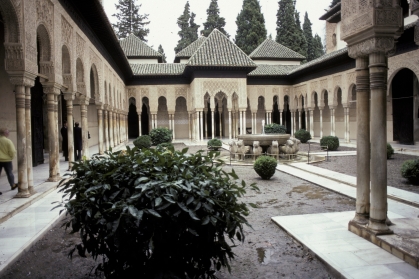Symmetry is a characteristic of nature; it is not something that has been invented by artists and architects. Symmetry has been well investigated by mathematicians and crystallographers, and there is nothing for art historians to add to their work. But there are combinations of symmetry and design principles are not captured by classifications of symmetry alone.

Figure 1. Court of the Lions, view to east from northwest corner.
This study properly begins in the Alhambra, well known for the symmetries of its decoration. For several decades I have wanted to investigate Georges Marçais's claim that the arcades of the Court of the Lions have multiple overlapping systems of symmetry. Having found the time to do so, as a preliminary I looked into symmetry itself. I realized that it is useful to employ the established terminology for symmetry and that combinations of symmetry and design principles are of interest and can be articulated using that terminology. In this article I review what symmetry is, introduce terminology for certain uses of symmetry in art, and trace these uses of symmetry in western Islamic architecture.
The sort of symmetry I have in mind to start with is symmetry in the mathematical sense, not the use of the word to mean that the parts of some whole are harmonious.1
1. Hermann Weyl, Symmetry, Princeton, 1952, p. 3; George Hersey, Architecture and Geometry in the Age of the Baroque, Chicago, 2000, chapter five, with a discussion of the history of the meaning of the word “symmetry”.